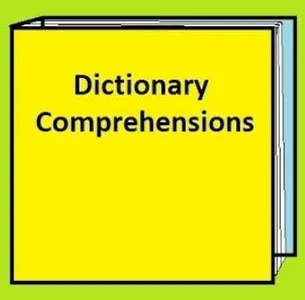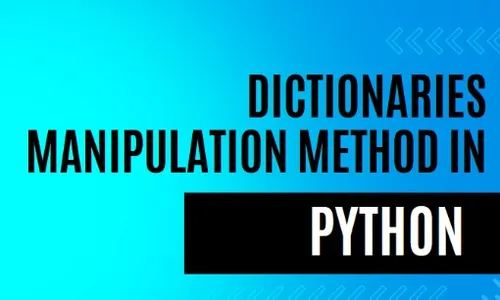Python Dictionary Comprehension: Mastering Data Manipulation with Precision
Introduction
Unlock the potential of Python’s data manipulation capabilities with the efficient and concise technique of dictionary comprehension. This article delves into the syntax, applications, and examples of dictionary comprehension in Python. From advanced strategies to potential pitfalls, explore how dictionary comprehension stacks up against other data manipulation methods.

Python Dictionary Comprehension Methods
Python offers dictionary comprehension as a concise and efficient way to create dictionaries from iterables. Here are some methods and examples of using dictionary comprehension in Python:
1. Basic Dictionary Comprehension:
Dictionary comprehension follows the syntax `{key: value for (key, value) in iterable}`. It iterates over each item in the iterable and constructs a dictionary where each key-value pair is determined by the expression inside the curly braces.
“`python
# Example: Squaring numbers from 1 to 5 and creating a dictionary
square_dict = {x: x**2 for x in range(1, 6)}# Output: {1: 1, 2: 4, 3: 9, 4: 16, 5: 25}“`
2. Conditional Dictionary Comprehension:
You can add conditions to filter elements in the iterable using an if statement inside the comprehension.
“`python
# Example: Creating a dictionary with even numbers as keys and their squares as values
even_square_dict = {x: x**2 for x in range(1, 11) if x % 2 == 0}# Output: {2: 4, 4: 16, 6: 36, 8: 64, 10: 100}“`
3. Using Functions in Dictionary Comprehension:
You can apply functions to the keys or values in the dictionary comprehension.
“`python
# Example: Creating a dictionary with lowercase letters as keys and their corresponding ASCII values as values
ascii_dict = {char: ord(char) for char in 'abcdefghijklmnopqrstuvwxyz'}# Output: {'a': 97, 'b': 98, ..., 'z': 122}“`
4. Nested Dictionary Comprehension:
You can also create nested dictionaries using dictionary comprehension.
“`python
# Example: Creating a nested dictionary with numbers as keys and their squares and cubes as values
nested_dict = {x: {'square': x**2, 'cube': x**3} for x in range(1, 6)}# Output: {1: {'square': 1, 'cube': 1}, 2: {'square': 4, 'cube': 8}, ..., 5: {'square': 25, 'cube': 125}}“`
Dictionary comprehension provides a concise and readable way to create dictionaries in Python, making your code more expressive and efficient.
Simplifying with Dictionary Comprehension python
Streamlining the dictionary creation process, dictionary comprehension harmonizes elements, expressions, and optional conditions. The result ? A fresh dictionary emerges without the burden of explicit loops and conditional statements.
Read more about Python Dictionaries- A Super Guide for a dictionaries in Python for Absolute Beginners
Syntax and Usage of Dictionary Comprehension
Master the syntax:
{key_expression: value_expression for element in iterable if condition}
The key_expression signifies the key for each element in the iterable, and the value_expression signifies the corresponding value. The variable ‘element’ adopts the value of each item in the iterable, and the condition, if specified, filters which elements are included in the dictionary.
Examples of Dictionary Comprehension in Python
Creating a Dictionary from Lists
Suppose we have two lists, one containing names and the other containing ages. We can use dictionary comprehension to create a dictionary where the names are the keys and the ages are the values.
names = ['Himanshu''Tarun''Aayush']
ages = [253035]
person_dict = {name: age for name, age in zip(names, ages)}
print(person_dict)
Output:
{‘Himanshu’: 25, ‘Tarun’: 30, ‘Aayush’: 35}
Filtering and Transforming Dictionary Elements
We can employ dictionary comprehension to filter and transform elements based on specific conditions. For instance, consider a scenario where we have a dictionary containing students and their scores. We can use dictionary comprehension to generate a new dictionary that includes only the students who achieved scores above a particular threshold.
scores = {'Himanshu': 80, 'Tarun': 90, 'Nishant': 70, 'Aayush': 85}
passing_scores = {name: score for name, score in scores.items() if score >= 80}
print(passing_scores)
Output:
{‘Himanshu': 80, ‘Tarun': 90, ‘Aayush': 85}Nested Dictionary Comprehension
Nested dictionaries can be created using dictionary comprehension, allowing for multiple levels of nesting. For instance, suppose we have a list of cities and their populations. In this case, we can use nested dictionary comprehension to generate a dictionary with cities as keys and corresponding values as dictionaries containing information such as population and country.
cities = ['New York''London', 'Paris']
populations = [8623000, 89080812140526]
countries = ['USA''UK''France']
city_dict = {city: {'population': population, 'country': country}
for city, population, country in zip(cities, populations, countries)}
print(city_dict)
Output:
{
‘New York': {‘population': 8623000, ‘country': ‘USA'},
‘London': {‘population': 8908081, ‘country': ‘UK'},
‘Paris': {‘population': 2140526, ‘country': ‘France'}
}Conditional Dictionary Comprehension
Conditional statements can be incorporated into dictionary comprehension to address specific cases. For instance, consider a scenario where there is a dictionary containing temperatures in Celsius. We can utilize dictionary comprehension to produce a new dictionary by converting temperatures to Fahrenheit, but exclusively for temperatures that are above freezing.
temperatures = {'New York': -2, 'London': 3, 'Paris': 1}
fahrenheit_temperatures = {city: temp * 9/5 + 32 for city,
temp in temperatures.items() if temp > 0}
print(fahrenheit_temperatures)
Output:
{‘London': 37.4, ‘Paris': 33.8}Dictionary Comprehension with Functions
Using functions in dictionary comprehension allows for the execution of complex operations on elements. For example, suppose there is a list of numbers. In this case, we can employ dictionary comprehension to directly create a dictionary where the numbers serve as keys and their corresponding squares as values.
numbers = [1, 345]
def square(num):
return num ** 2
squared_numbers = {num: square(num) for num in numbers}
print(squared_numbers)
Output:
{1: 1, 2: 4, 3: 9, 4: 16, 5: 25}Tips and Tricks for Dictionary Comprehension
Dictionary comprehension is a powerful tool in Python for creating dictionaries with elegance and conciseness. While it simplifies the process, mastering some tips and tricks can further elevate your data manipulation skills. Let’s delve into these advanced techniques:

- Handling Duplicate Keys: Address duplicate keys by employing set comprehension to eliminate duplicates before constructing the dictionary. This ensures each key retains its unique value.
- Combining with Set Comprehension: Combine dictionary comprehension with set comprehension for dictionaries with unique keys. Ideal for scenarios where data may contain duplicate keys, this technique enhances clarity and avoids key conflicts.
- Combining Multiple Dictionaries: Merge dictionaries or create new ones by combining multiple dictionaries through dictionary comprehension. This technique provides flexibility when dealing with diverse datasets.
- Optimizing Performance: Optimize the performance of dictionary comprehension, especially with large datasets, by using generator expressions instead of lists. This approach enhances memory efficiency and overall execution speed.
Comparison with Other Data Manipulation Techniques
Dictionary Comprehension vs. For Loops
Dictionary comprehension provides a more concise and readable method for creating dictionaries compared to traditional for loops. It removes the necessity for explicit loop initialization, iteration, and manual appending to the dictionary.
Using For Loops
data = [('a', 1), ('b', 2), ('c', 3)]
result = {}
for key, value in data:
result[key] = value
print(result)
Using Dictionary Comprehension:
# Dictionary Comprehension for the same task
data = [('a', 1), ('b', 2), ('c', 3)]
result = {key: value for key, value in data}
print(result)
Dictionary Comprehension vs. Map and Filter Functions
Dictionary comprehension can be seen as a combination of map and filter functions. It allows us to transform and filter elements simultaneously, resulting in a new dictionary.
Using Map and Filter
# Using map and filter to create a dictionary
data = [('a', 1), ('b', 2), ('c', 3)]
result = dict(map(lambda x: (x[0], x[1]*2), filter(lambda x: x[1] % 2 == 0, data)))
print(result)
Using Dictionary Comprehension:
# Dictionary Comprehension for the same task
data = [('a', 1), ('b', 2), ('c', 3)]
result = {key: value*2 for key, value in data if value % 2 == 0}
print(result)
Dictionary Comprehension vs. Generator Expressions
Generator expressions, like list comprehensions, produce iterators rather than lists. When utilized in dictionary comprehension, they enhance memory efficiency, particularly when managing substantial datasets.
Using Generator Expressions:
# Generator Expression to create an iterator
data = [('a', 1), ('b', 2), ('c', 3)]
result_generator = ((key, value*2for key, value in data if value % 2 == 0# Convert the generator to a dictionary
result = dict(result_generator)
print(result)
Using Dictionary Comprehension:
# Dictionary Comprehension with the same condition
data = [('a', 1), ('b', 2), ('c', 3)]
result = {key: value*2 for key, value in data if value % 2 == 0}
print(result)
Common Pitfalls and Mistakes to Avoid

Overcomplicating Dictionary Comprehension
Avoid unnecessarily complicating expressions or conditions within dictionary comprehension. Prioritize simplicity and readability to ensure transparent code and ease of maintenance.
Incorrect Syntax and Variable Usage
Using incorrect syntax or variable names in dictionary comprehension is a common mistake. It is crucial to verify the syntax and ensure consistency between the variable names in the comprehension and those in the iterable.
Not Handling Edge Cases and Error Handling
Handling edge cases and implementing error handling is essential when employing dictionary comprehension. This involves addressing scenarios such as an empty iterable or potential errors arising from the conditions specified in the comprehension.
By steering clear of these common pitfalls, you fortify your dictionary comprehension skills, ensuring that your code remains not just concise but also resilient to various data scenarios. Embrace these guidelines to elevate your proficiency in Python’s data manipulation landscape.
Conclusion
Python dictionary comprehension empowers data manipulation by simplifying the creation of dictionaries. Eliminate the need for explicit loops and conditions, and enhance your data manipulation skills. Dive into this comprehensive guide and leverage the efficiency and elegance of dictionary comprehension in your Python projects.
You can also learn about list comprehension from here.
Frequently Asked Questions?
A. Dictionary comprehension enables creating a Python dictionary from a single line. This method produces a dictionary using itserable objects such as lists or tuples. Dictionary comprehension is also able filter and modify Keyvalue pairs according to specified conditions. 27th October 2019.
A. This syntax resembles ListComprehension’s. Arrays return generators. A Dictionary comprehension is a separate form of dict comprehension which contains two expressions separating by a colon. It is also feasible to tuple lists or set comprehensions. June 22 2020.
A. I hope I have convinced your mind that dictionaries and lexicomations can help create dictionaries using an iterator. It is faster than passing tuple lists to dict() functions. And although not so fast as for loops, dictionary comprehensions are much simpler.
A. Dictionary comprehension is based upon Python programming languages to generate dictionary in just a single word. Typically the method creates an iterable dictionary by importing lists, tuples and other objects. Dictionary comprehension can be used to filter key values or modify key values in arbitrary situations.








